Content for TS 37.340 Word version: 18.2.0
1…
4…
4.2…
4.3…
5…
7…
8…
9
10…
10.2…
10.2.2…
10.3…
10.3.2
10.4…
10.5…
10.5.2
10.6
10.7…
10.8…
10.9…
10.10…
10.11…
10.12…
10.12.2
10.13…
10.14…
10.15
10.16…
10.17…
10.18…
10.19…
10.20
11…
A
B…
10.3.2 MR-DC with 5GC p. 46
The SN Modification procedure may be initiated either by the MN or by the SN and be used to modify the current user plane resource configuration (e.g. related to PDU session, QoS flow or DRB) or to modify other properties of the UE context within the same SN. It may also be used to transfer an RRC message from the SN to the UE via the MN and the response from the UE via MN to the SN (e.g. when SRB3 is not used). In NGEN-DC and NR-DC, the RRC message is an NR message (i.e., RRCReconfiguration) whereas in NE-DC it is an E-UTRA message (i.e., RRCConnectionReconfiguration). In case of CPA, inter-SN CPC or inter-SN subsequent CPAC, this procedure is used to modify CPA, inter-SN CPC or inter-SN subsequent CPAC configuration within the same candidate SN. In case of CPA, inter-SN CPC or inter-SN subsequent CPAC, this procedure may also be triggered by the candidate SN to add some prepared PSCells from the suggested list or cancel part of the prepared PSCells. In case of intra-SN CPC or intra-SN subsequent CPAC, this procedure is used to configure, modify or release intra-SN CPC or intra-SN subsequent CPAC configuration. In case of intra-SN SCG LTM, this procedure is used to configure, modify or release intra-SN SCG LTM configuration. This procedure may be initiated by the MN or SN to request the SN or MN to activate or deactivate the SCG. This procedure can also be used to support coordination between the MN and the SN for managing the configuration and reporting of QoE measurements and/or RAN visible QoE measurements in NR-DC.
The SN modification procedure does not necessarily need to involve signalling towards the UE.
MN initiated SN Modification
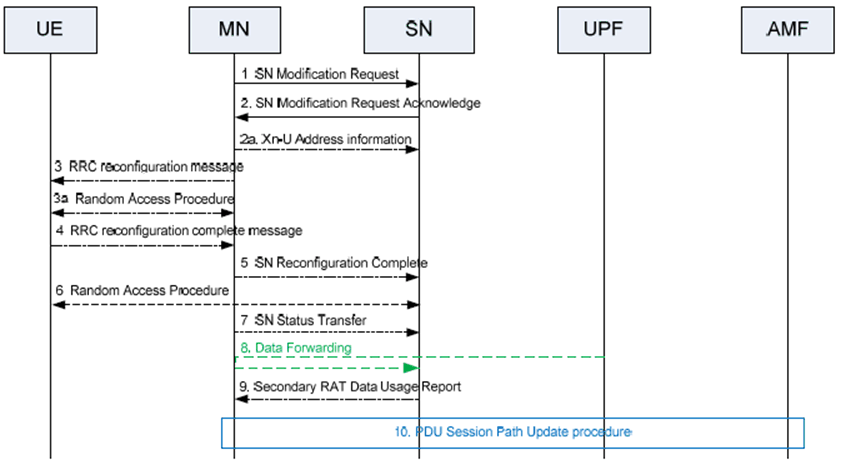
The MN uses the procedure to initiate configuration changes of the SCG within the same SN, including addition, modification or release of the user plane resource configuration. The MN uses this procedure to perform handover within the same MN while keeping the SN, when the SN needs to be involved (i.e. in NGEN-DC). The MN also uses the procedure to query the current SCG configuration, e.g. when delta configuration is applied in an MN initiated SN change. The MN also uses the procedure to provide the S-RLF related information to the SN or to provide additional available DRB IDs to be used for SN terminated bearers. The MN also uses this procedure to activate or deactivate the SCG. The MN may not use the procedure to initiate the addition, modification or release of SCG SCells. The SN may reject the request, except if it concerns the release of the user plane resource configuration, or if it is used to perform handover within the same MN while keeping the SN. Figure 10.3.2-1 shows an example signalling flow for an MN initiated SN Modification procedure.
Step 1.
SN initiated SN Modification with MN involvement
The MN sends the SN Modification Request message, which may contain user plane resource configuration related or other UE context related information, PDU session level Network Slice info and the requested SCG configuration information, including the UE capabilities coordination result to be used as basis for the reconfiguration by the SN. In case a security key update in the SN is required, a new SN Security Key is included. In case the PDCP data recovery in the SN is required, the PDCP Change Indication is included which indicates that PDCP data recovery is required in SN. In case of coordination between the MN and the SN on QoE and/or RAN visible QoE measurement configuration and reporting, the SN Modification Request message may contain the QMC Coordination Request IE.
Step 2.
The SN responds with the SN Modification Request Acknowledge message, which may contain new SCG radio configuration information within an SN RRC reconfiguration message, and data forwarding address information (if applicable). If the MN requested the SCG to be activated or deactivated, the SN indicates whether the SCG is activated or deactivated. In case of coordination between the MN and the SN on QoE and/or RAN visible QoE measurement configuration and reporting, the SN Modification Request Acknowledge message may contain the QMC Coordination Response IE.
For SN terminated bearers to be setup for which PDCP duplication with CA is configured in NR MCG side, the SN allocates up to 4 separate Xn-U bearers and the MN provides a logical channel ID for primary or split secondary path to the SN via an additional MN-initiated SN modification procedure.
Step 2a.
When applicable, the MN provides data forwarding address information to the SN. For SN terminated bearers using MCG resources, the MN provides Xn-U DL TNL address information in the Xn-U Address Indication message.
Step 3/4.
The MN initiates the RRC reconfiguration procedure, including an SN RRC reconfiguration message. The UE applies the new configuration, synchronizes to the MN (if instructed, in case of intra-MN handover) and replies with MN RRC reconfiguration complete message, including an SN RRC response message, if needed. In case the UE is unable to comply with (part of) the configuration included in the MN RRC reconfiguration message, it performs the reconfiguration failure procedure.
Step 5.
Upon successful completion of the reconfiguration, the success of the procedure is indicated in the SN Reconfiguration Complete message.
Step 6.
If instructed, the UE performs synchronisation towards the PSCell of the SN as described in SN addition procedure. Otherwise, the UE may perform UL transmission after having applied the new configuration.
Step 7.
If PDCP termination point is changed for bearers using RLC AM, and when RRC full configuration is not used, the SN Status Transfer takes place between the MN and the SN (Figure 10.3.2-1 depicts the case where a bearer context is transferred from the MN to the SN).
Step 8.
If applicable, data forwarding between MN and the SN takes place (Figure 10.3.2-1 depicts the case where a user plane resource configuration related context is transferred from the MN to the SN).
Step 9.
The SN sends the Secondary RAT Data Usage Report message to the MN and includes the data volumes delivered to and received from the UE as described in clause 10.11.2.
Step 10.
If applicable, a PDU Session path update procedure is performed.
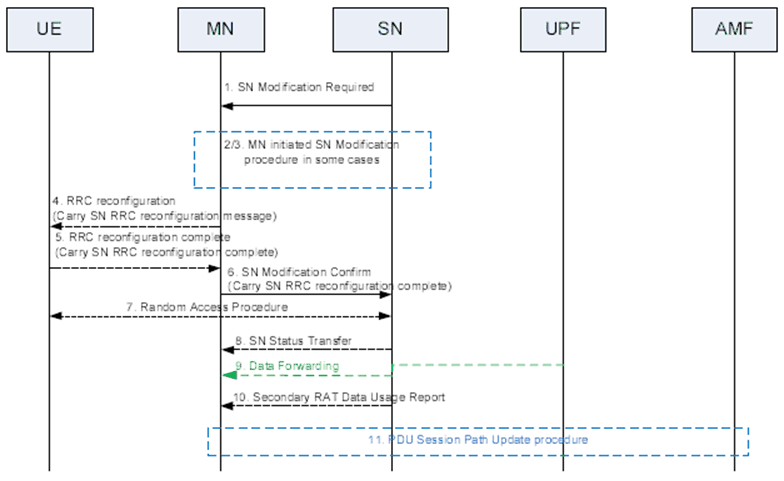
The SN uses the procedure to perform configuration changes of the SCG within the same SN, e.g. to trigger the modification/release of the user plane resource configuration, to trigger the release of SCG resources (e.g., release SCG lower layer resources but keep SN), and to trigger PSCell changes (e.g. when a new security key is required or when the MN needs to perform PDCP data recovery). The MN cannot reject the release request of PDU session/QoS flows and the release request of SCG resources. The SN also uses the procedure to request the MN to provide more DRB IDs to be used for SN terminated bearers or to return DRB IDs used for SN terminated bearers that are not needed any longer. The SN also uses this procedure to activate or deactivate the SCG. Figure 10.3.2-2 shows an example signalling flow for SN initiated SN Modification procedure.
This procedure is not supported for NE-DC.
Step 1.
SN initiated SN Modification without MN involvement
The SN sends the SN Modification Required message including an SN RRC reconfiguration message, which may contain user plane resource configuration related context, other UE context related information and the new radio resource configuration of SCG. The SN may request the SCG to be activated or deactivated. In case of change of security key, the PDCP Change Indication indicates that an SN security key update is required. In case the MN needs to perform PDCP data recovery, the PDCP Change Indication indicates that PDCP data recovery is required. In case of coordination between the MN and the SN on QoE and/or RAN visible QoE measurement configuration and reporting, the SN Modification Required message may contain the QMC Coordination Request IE.
The SN can decide whether the change of security key is required.
Step 2/3.
The MN initiated SN Modification procedure may be triggered by SN Modification Required message, e.g. when an SN security key change needs to be applied.
Step 4.
The MN sends the MN RRC reconfiguration message to the UE including the SN RRC reconfiguration message with the new SCG radio resource configuration.
Step 5.
The UE applies the new configuration and sends the MN RRC reconfiguration complete message, including an SN RRC response message, if needed. In case the UE is unable to comply with (part of) the configuration included in the MN RRC reconfiguration message, it performs the reconfiguration failure procedure.
Step 6.
Upon successful completion of the reconfiguration, the success of the procedure is indicated in the SN Modification Confirm message including the SN RRC response message, if received from the UE. In case of coordination between the MN and the SN on QoE and/or RAN visible QoE measurement configuration and reporting, the SN Modification Confirm message may contain the QMC Coordination Response IE.
Step 7.
If instructed, the UE performs synchronisation towards the PSCell configured by the SN as described in SN Addition procedure. Otherwise, the UE may perform UL transmission directly after having applied the new configuration.
Step 8.
If PDCP termination point is changed for bearers using RLC AM, and when RRC full configuration is not used, the SN Status Transfer takes place between the MN and the SN (Figure 10.3.2-2 depicts the case where a bearer context is transferred from the SN to the MN).
Step 9.
If applicable, data forwarding between MN and the SN takes place (Figure 10.3.2-2 depicts the case where a user plane resource configuration related context is transferred from the SN to the MN).
Step 10.
The SN sends the Secondary RAT Data Usage Report message to the MN and includes the data volumes delivered to and received from the UE as described in clause 10.11.2.
Step 11.
If applicable, a PDU Session path update procedure is performed.
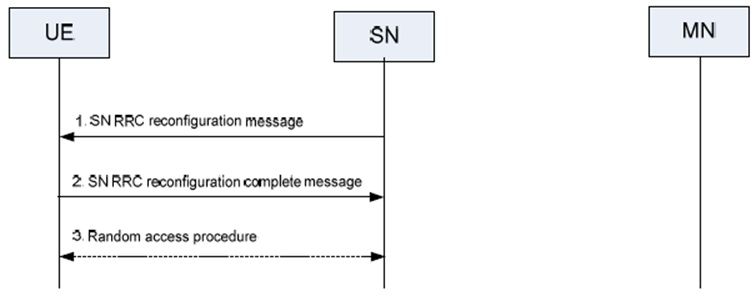
The SN initiated SN modification procedure without MN involvement is used to modify the configuration within SN in case no coordination with MN is required, including the addition/modification/release of SCG SCell and PSCell change (e.g. when the security key does not need to be changed and the MN does not need to be involved in PDCP recovery). The SN may initiate the procedure to configure, modify or release intra-SN CPC or intra-SN subsequent CPAC configuration within the same SN. The SN may initiate the procedure to configure, modify or release intra-SN SCG LTM configuration within the same SN. Figure 10.3.2-3 shows an example signalling flow for SN initiated SN modification procedure without MN involvement. The SN can decide whether the Random Access procedure is required.
This procedure is not supported for NE-DC and NGEN-DC.
Step 1.
SN initiated Conditional SN Modification without MN involvement (SRB3 is used)
The SN sends the SN RRC reconfiguration message to the UE through SRB3.
Step 2.
The UE applies the new configuration and replies with the SN RRC reconfiguration complete message. In case the UE is unable to comply with (part of) the configuration included in the SN RRC reconfiguration message, it performs the reconfiguration failure procedure.
Step 3.
If instructed, the UE performs synchronisation towards the PSCell of the SN as described in SN Addition procedure. Otherwise the UE may perform UL transmission after having applied the new configuration.
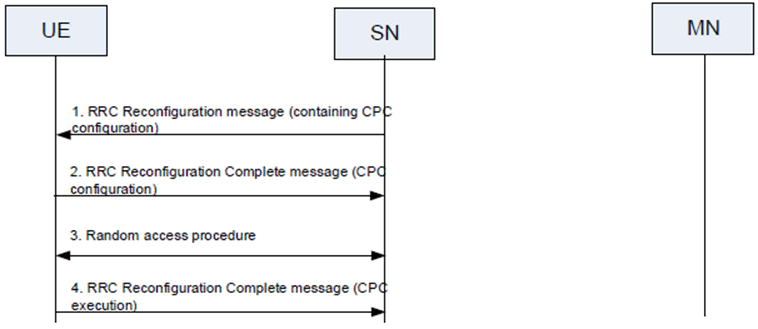
The SN initiates the procedure when it needs to transfer an NR RRC message to the UE and SRB3 is used to configure intra-SN CPC or intra-SN subsequent CPAC.
This procedure is not supported for NE-DC and NGEN-DC.
Step 1.
SN initiated SCG LTM without MN involvement (SRB3 is used)
The SN sends the SN RRC reconfiguration including CPC configuration or subsequent CPAC configuration to the UE through SRB3.
Step 2.
The UE applies the new configuration. In case the UE is unable to comply with (part of) the configuration included in the SN RRC reconfiguration message, it performs the reconfiguration failure procedure. The UE starts evaluating the execution conditions for the candidate PSCell(s). The UE maintains connection with the source PSCell and replies with the RRCReconfigurationComplete message to the SN via SRB3.
Step 3.
If at least one candidate PSCell satisfies the corresponding execution condition, the UE detaches from the source PSCell, applies the stored configuration corresponding to the selected candidate PSCell and synchronises to the candidate PSCell. In subsequent CPAC, the UE keeps the configured subsequent CPAC configuration and evaluates the execution conditions of other candidate PSCells after completion of the subsequent CPAC execution.
Step 4.
The UE completes the CPC execution procedure by sending an RRCReconfigurationComplete message to the new PSCell.

The SN initiates the procedure when it needs to transfer an NR RRC message to the UE and SRB3 is used to configure intra-SN SCG LTM.
This procedure is supported for all the MR-DC options.
Step 1.
Transfer of an NR RRC message to/from the UE (when SRB3 is not used)
The SN sends the SN RRCReconfiguration including SCG LTM candidate configurations to the UE through SRB3.
Step 2.
The UE stores the SCG LTM candidate configurations and transmits an RRCReconfigurationComplete message to the SN.
Step 3a.
The UE performs DL synchronization with LTM candidate cell(s) before receiving the cell switch command, as specified in clause 9.2.3.5.2 in TS 38.300.
Step 3b.
The UE may perform UL synchronization with LTM candidate cell(s) before receiving the cell switch command, as specified in clause 9.2.3.5.2 in TS 38.300.
Step 4.
The UE performs L1 measurements on the configured LTM candidate cell(s) and transmits L1 measurement reports to the SN, according to the L1 measurement configuration in RRCReconfiguration received in step 1. The UE starts to perform L1 measurements once the L1 measurement configuration is applicable.
Step 5.
The SN decides to execute cell switch to a target cell and transmits an LTM cell switch command MAC CE triggering cell switch by including a target configuration ID and other related information for the target cell, as specified in clause 9.2.3.5.2 in TS 38.300. The UE switches to the target cell and applies the candidate configuration indicated by the target configuration ID.
Step 6.
The UE performs the random access procedure towards the target cell, if the UE does not have valid TA of the target cell.
Step 7.
The UE completes the SCG LTM cell switch procedure by sending RRCReconfigurationComplete message to target cell. If the UE has performed a RA procedure in step 6 the UE considers that LTM execution is successfully completed when the random access procedure is successfully completed. For RACH-less LTM, the UE considers that LTM cell switch execution is successfully completed when the UE determines that the target cell has successfully received its first UL data, as specified in clause 9.2.3.5.2 in TS 38.300.
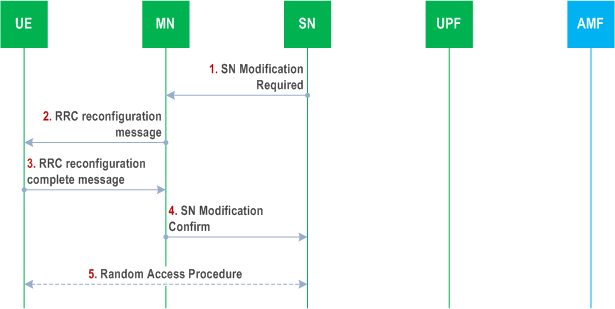
The SN initiates the procedure when it needs to transfer an NR RRC message to the UE and SRB3 is not used.
This procedure is not supported for NE-DC and NGEN-DC.
Step 1.
SN initiated Conditional SN Modification without MN involvement (SRB3 is not used)
The SN initiates the procedure by sending the SN Modification Required to the MN including the SN RRC reconfiguration message.
Step 2.
The MN forwards the SN RRC reconfiguration message to the UE including it in the RRC reconfiguration message.
Step 3.
The UE applies the new configuration and replies with the RRC reconfiguration complete message by including the SN RRC reconfiguration complete message. In case the UE is unable to comply with (part of) the configuration included in the SN RRC reconfiguration message, it performs the reconfiguration failure procedure.
Step 4.
The MN forwards the SN RRC response message, if received from the UE, to the SN by including it in the SN Modification Confirm message.
Step 5.
If instructed, the UE performs synchronisation towards the PSCell of the SN as described in SN Addition procedure. Otherwise the UE may perform UL transmission after having applied the new configuration.
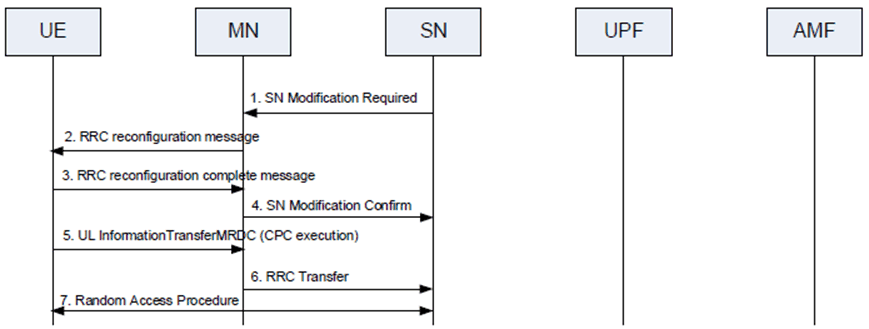
The SN initiates the procedure when it needs to transfer an NR RRC message to the UE and SRB3 is not used to configure intra-SN CPC or intra-SN subsequent CPAC.
This procedure is not supported for NE-DC and NGEN-DC.
Step 1.
SN initiated SCG LTM without MN involvement (SRB3 is not used)
The SN initiates the procedure by sending the SN Modification Required to the MN including the SN RRC reconfiguration message with CPC configuration or subsequent CPAC configuration.
Step 2.
The MN forwards the SN RRC reconfiguration message to the UE including it in the RRCReconfiguration message.
Step 3.
The UE replies with the RRCReconfigurationComplete message by including the SN RRC reconfiguration complete message. In case the UE is unable to comply with (part of) the configuration included in the SN RRC reconfiguration message, it performs the reconfiguration failure procedure. The UE maintains connection with source PSCell after receiving CPC configuration or subsequent CPAC configuration, and starts evaluating the execution conditions for the candidate PSCell(s).
Step 4.
The MN forwards the SN RRC response message, if received from the UE, to the SN by including it in the SN Modification Confirm message.
Step 5.
If at least one candidate PSCell satisfies the corresponding execution condition, the UE completes the CPC execution procedure by an ULInformationTransferMRDC message to the MN which includes an embedded RRCReconfigurationComplete message to the selected target PSCell. In subsequent CPAC, the UE keeps the configured subsequent CPAC configuration and evaluates the execution conditions of other candidate PSCells after completion of the subsequent CPAC execution.
Step 6.
The RRCReconfigurationComplete message is forwarded to the SN embedded in RRC Transfer message.
Step 7.
The UE detaches from the source PSCell, applies the stored corresponding configuration and synchronises to the selected candidate PSCell.

The SN initiates the procedure when it needs to transfer an NR RRC message to the UE and SRB3 is not used to configure intra-SN SCG LTM.
Step 1.
The SN initiates the procedure by sending the SN Modification Required to the MN including the SN RRCReconfiguration message with SCG LTM candidate configurations.
Step 2.
The MN forwards the SN RRCReconfiguration message to the UE including it in the RRCReconfiguration message.
Step 3.
The UE stores the SCG LTM candidate configurations and replies with the RRCReconfigurationComplete message by including the SN RRCReconfigurationComplete message.
Step 4.
The MN forwards the SN RRC response message, if received from the UE, to the SN by including it in the SN Modification Confirm message.
Step 5a.
The UE performs DL synchronization with LTM candidate cell(s) before receiving the cell switch command, as specified in clause 9.2.3.5.2 in TS 38.300.
Step 5b.
The UE may perform UL synchronization with LTM candidate cell(s) before receiving the cell switch command, as specified in clause 9.2.3.5.2 in TS 38.300.
Step 6.
The UE performs L1 measurements on the configured LTM candidate cell(s) and transmits L1 measurement reports to the SN, according to the L1 measurement configuration in RRCReconfiguration received in step 2. The UE starts to perform L1 measurements once the L1 measurement configuration is applicable.
Step 7.
The SN decides to execute cell switch to a target cell and transmits an LTM cell switch command MAC CE triggering cell switch by including a target configuration ID and other related information for the target cell, as specified in clause 9.2.3.5.2 in TS 38.300. The UE switches to the target cell and applies the candidate configuration indicated by the target configuration ID.
Step 8.
The UE sends an ULInformationTransferMRDC message to the MN which includes an embedded RRCReconfigurationComplete message to the target cell.
Step 9.
The RRCReconfigurationComplete message is forwarded to the SN embedded in RRC Transfer message.
Step 10.
The UE performs the random access procedure towards the target cell, if the UE does not have valid TA of the target cell.
Step 11.
The UE completes the SCG LTM cell switch procedure by sending an UL transmission to target cell. If the UE has performed a RA procedure in step 10 the UE considers that LTM execution is successfully completed when the random access procedure is successfully completed. For RACH-less LTM, the UE considers that LTM execution is successfully completed when the UE determines that the SN has successfully received its first UL transmission, as specified in clause in clause 9.2.3.5.2 in TS 38.300.